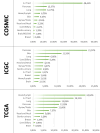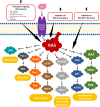The complex journey of targeting RAS in oncology
- PMID: 40597785
- PMCID: PMC12211582
- DOI: 10.1186/s12885-025-14033-y
The complex journey of targeting RAS in oncology
Abstract
Given the prevalence of RAS mutations in various cancers, personalized therapeutic approaches, guided by molecular markers, are essential. Farnesyltransferase inhibitors (FTIs) have emerged as potential therapeutic options; however, they also face obstacles such as toxicity and limited efficacy. Alternative strategies, such as direct inhibitors combined with pathway modulators, RNA interference, and gene-editing technologies, are under clinical investigation. The targeting of RAS, complicated by its structural nuances, particularly in the G domain, has advanced with the identification of druggable pockets such as the SW-II pocket. This breakthrough has led to the development of targeted therapeutics, such as sotorasib and adagrasib, for KRAS G12C-mutated non-small cell lung cancer (NSCLC). However, these advancements face challenges, including adaptive resistance and the necessity for isoform selectivity. New inhibitors, such as LY3537982 or GDC-6036, are promising, but achieving effective and selective RAS inhibition remains a significant challenge. Additionally, clinical trials have highlighted variability in patient responses, attributing limited treatment efficacy to resistance mechanisms, including on-target mutations and off-target pathway activations. Finally, the RAS oncogene, traditionally viewed as predominantly pro-cancerous, plays a complex role in oncogenesis, with recent evidence suggesting context-dependent effects, such as inducing senescence in certain cells. This shift in understanding underscores the therapeutic potential of manipulating the interplay between RAS and TP53 mutations in cancer. In conclusion, the complexity of effectively targeting the RAS-RAF-ERK pathway is exacerbated by the diverse resistance mechanisms. Challenges such as off-target effects and delivery issues remain significant barriers in the introduction of effective therapies based on RAS inhibitors. This overview highlights the evolving nature of targeting RAS in cancer therapy.
Keywords: Cancer; Drug discovery; HRAS; KRAS; NRAS; Oncogene; Protein structure; RAS proteins; Senescence; Therapy.
© 2025. The Author(s).
Conflict of interest statement
Declarations. Competing interests: The authors declare no competing interests.
Figures







Similar articles
-
A rapid and systematic review of the clinical effectiveness and cost-effectiveness of paclitaxel, docetaxel, gemcitabine and vinorelbine in non-small-cell lung cancer.Health Technol Assess. 2001;5(32):1-195. doi: 10.3310/hta5320. Health Technol Assess. 2001. PMID: 12065068
-
Differential Response and Resistance to KRAS-Targeted Therapy.Mol Carcinog. 2025 Jul;64(7):1135-1148. doi: 10.1002/mc.23908. Epub 2025 Apr 21. Mol Carcinog. 2025. PMID: 40256920 Review.
-
An updated overview of K-RAS G12C inhibitors in advanced stage non-small cell lung cancer.Future Oncol. 2024;20(37):3019-3038. doi: 10.1080/14796694.2024.2407280. Epub 2024 Oct 3. Future Oncol. 2024. PMID: 39360933 Review.
-
Recent advances in targeted degradation in the RAS pathway.Future Med Chem. 2025 Mar;17(6):693-708. doi: 10.1080/17568919.2025.2476387. Epub 2025 Mar 10. Future Med Chem. 2025. PMID: 40065567 Review.
-
Oncogenic KRAS blockade therapy: renewed enthusiasm and persistent challenges.Mol Cancer. 2021 Oct 4;20(1):128. doi: 10.1186/s12943-021-01422-7. Mol Cancer. 2021. PMID: 34607583 Free PMC article. Review.
Cited by
-
Research progress on the mechanisms of CSF3R mutations in leukemogenesis and treatment strategies.Cancer Cell Int. 2025 Aug 14;25(1):304. doi: 10.1186/s12935-025-03941-5. Cancer Cell Int. 2025. PMID: 40813694 Free PMC article. Review.
References
-
- Parker JA, Mattos C. The Ras-membrane interface: isoform-specific differences in the catalytic domain. Mol Cancer Res. 2015;13:595–603. - PubMed
Publication types
MeSH terms
Substances
Grants and funding
LinkOut - more resources
Full Text Sources
Medical
Research Materials
Miscellaneous

